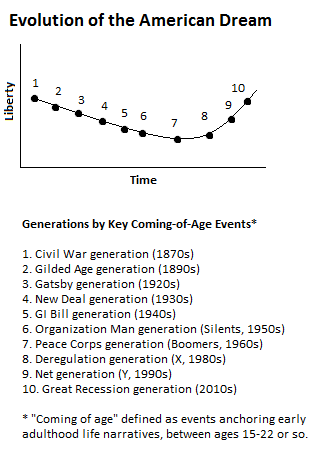 |
| The Laetoli footprints of Tanzania date back to approximately 3.5 million years: the original Mall-crawl. |
EVERYWHERE AND EVERYWHEN, people have tried to cope, tried to "get ahead", tried to prevail. Different times and different scenery produce different challenges and different perspectives from common-sense survival to the sophistry of delusional abstraction.
Venkatesh Rao, has a post on his RIBBONFARM site that is worthy of pondering, "The Evolution of the American Dream".
Remember the pigs in George Orwell’s Animal Farm and their sloganeering? In the beginning of the story, when they overthrow the humans, they lead with the chant, “four legs good, two legs bad!” By the end, they’ve become human-corrupt, and lead the chant, “four legs good, two legs better!”
Just one word changed, and the new and old words both begin with b, bolstering the illusion of continuity and natural evolution.
Let’s call such a slowly shifting narrative, simple enough to be captured in a slogan, and designed to help a small predatory class dominate a larger prey class, a Pig Narrative. The American Dream is a Pig Narrative.
Just one word changed, and the new and old words both begin with b, bolstering the illusion of continuity and natural evolution.
Let’s call such a slowly shifting narrative, simple enough to be captured in a slogan, and designed to help a small predatory class dominate a larger prey class, a Pig Narrative. The American Dream is a Pig Narrative.
Venkatesh seems to have a point here. A Pig Narrative, indeed. But that's not the reason I'm posting this. The reason is that Venkatesh presents an interesting list of generations in the evolution of the U.S. as a country, below:
You can compare Pig Narratives on the basis of the degree of prey liberty (or conversely, predator control) they represent, allowing you to plot the evolution over time. If you plot the course of the American Dream through its many rewrites (9 so far by my count, each associated with a major coming-of-age event that defined a generation), you get something like the picture above.
Now, IMHO, this is where the perspectives become fascinating:
- Civil War generation (1870s):
If I Go West as a Young Man, and work hard, I have as good a chance as anyone else of making it (gold miner, wildcatter) - Gilded Age generation (1890s):
If I work hard, I can make it (Horatio-Alger-inspired young people working for Robber Barons) - Gatsby generation (1920s):
Anybody can make it (Gatsby type easy money) - New Deal generation (1930s):
Together, we can make it* (worker building Hoover Dam) - GI Bill generation (1940s):
Any American can make it if he fights hard (WW II veteran, college-educated and starting high-responsibility job white collar job with young, growing American post-war companies) - Organization Man generation (Silents, 1950s):
I already have it; if I don’t screw it up, I can keep it (employee of mature, wealthy post-war company) - Peace Corps generation (Boomers, 1960s):
Americans already have it; we should share it (progressive, generous child of Cold War prosperity) - Deregulation generation (X, 1980s):
We’re losing it. If I keep my head down and step around the falling rubble smartly, I may escape (entering workforce among layoffs and uncertainty in manufacturing) - Net generation (Y, late 1990s):
We’re losing it. I don’t know what to do, I’ll go Occupy Wall Street (this generation lived through a boom and a bust and 9/11 while coming of age, turning the pig narrative into garbage at the starting gate, leaving a harsh, anomic landscape) - Next generation (coming of age right now ):
If I Go East as a Young Person, and work hard, I have as good a chance as anyone else of making it (lifestyle entrepreneur in Asia or Eastern Europe — this script will likely take shape with the 2016 election, when the generation is first courted by politicians).



1 comment:
Your post is very nice and informative it is very useful for music entertainment we are also work in this field and welcome you to visit our website.
Post a Comment